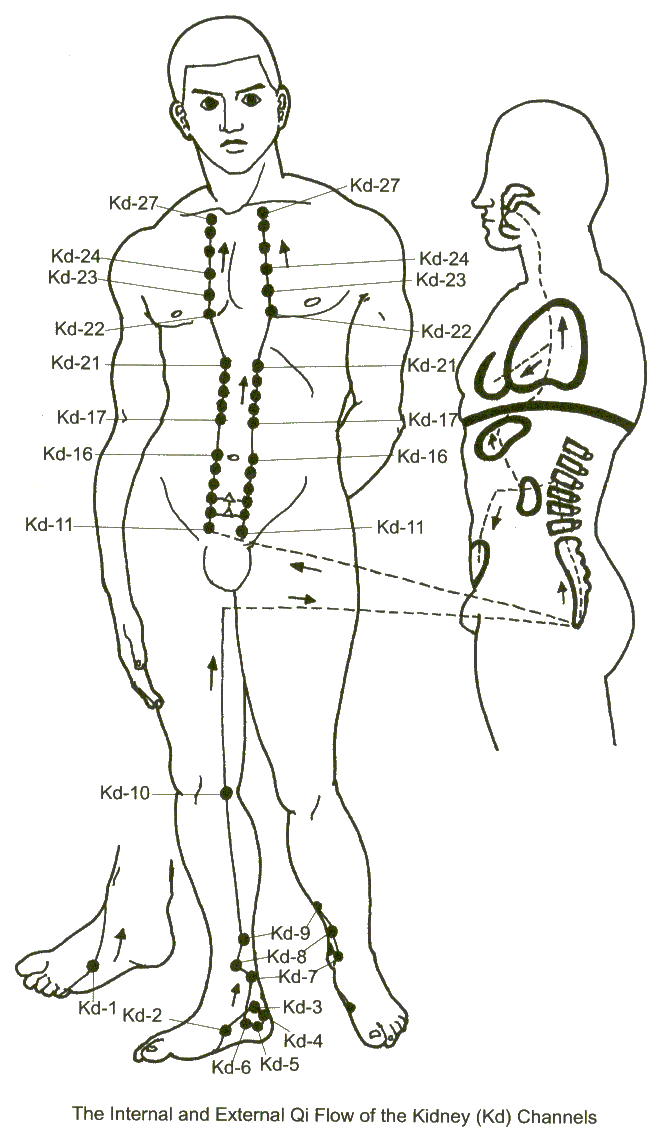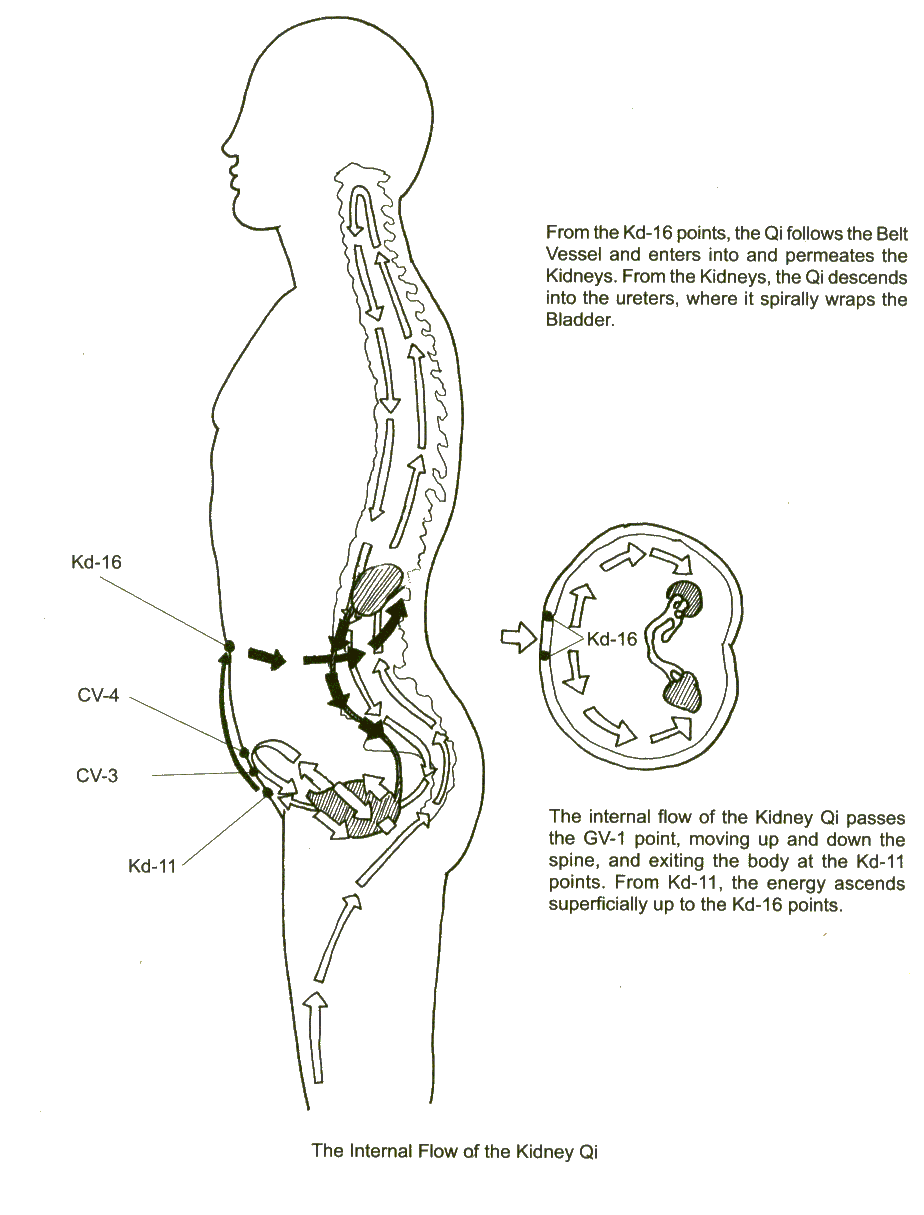
Kidney: Water-energy yin organ

Kidney:
Water-energy yin organ
Known as the 'Minister of Power', the kidney is regarded as the body's most important reservoir of essential energy. The original prenatal energy (yuan chee) which forms the basis of life is stored in the kidney organ-energy system, which is why the kidneys are also known as the 'Root of Life'. In the Chinese view, the kidney organ system also includes the adrenal glands, which consist of the adrenal medulla and the adrenal cortex. These glands sit like hats on top of the kidneys and secrete a wide range of essential hormones that regulate metabolism, excretion, immunity, sexual potency and fertility. Destruction of the adrenal cortex is fatal. The kidney system also includes what the Chinese call the 'external kidneys': the testicles in men and the ovaries in women. Thus the kidneys control sexual and reproductive functions and provide the body's prime source of sexual vitality, which the Chinese regard as a major indicator of health and immunity.
The kidneys themselves are responsible for filtering waste metabolites from the blood and moving them onwards to the bladder for excretion in urine. Along with the large intestine, the kidneys control the balance of fluids in the body. In addition, they regulate the body's acid-alkaline balance (pH) by selectively filtering out or retaining various minerals.
The kidneys, particularly the adrenal glands, are especially vulnerable to damage from excessive stress and sexual abuse. In the Chinese view, such damage is a major cause of immune deficiency, low vitality, and sexual impotence.
The kidneys control the growth and development of bones and nourish the marrow, which is the body's source of red and white blood cells. Weak kidney energy is therefore a prime cause of anemia and immune deficiency. The Chinese view the spinal cord and the brain as forms of marrow, and therefore poor memory, inability to think clearly, and backache are all regarded as indicators of impaired kidney function and deficient kidney energy.
Kidney vitality is reflected externally by the condition of head and body hair and is associated with the aperture of the ears. Tinnitus (ringing ears) is thus a sign of kidney dysfunction. The kidneys are the seat of courage and willpower, and therefore any impairment in kidney energy results in feelings of fear and paranoia. Intense fear can cause involuntary urination, a phenomenon also known to Western medicine.
|
Kidney |
|
| Paired Organ | Bladder |
| Color | light flame blue |
| Peak Hours | 5pm-7pm |
| Mental Qualities | fear, paranoia |
| Physical Branches | ears, bones, urine, head and pubic hair, brain, marrow |
| Functions | stores prenatal essence, filters the blood |
Kidney: Psycho-Emotional Aspects
The Marrow produced from the Kidney Jing flows into the brain. The thinking ability is strengthened when Qi and Blood in the cerebral cortex are abundant. With the increase of thinking activity, a circle of light develops within the body's Taiji Pole. The individual's innate intelligence (Yuan Shen) is represented by the intensity of light. The degree of accumulated spiritual energy is reflected by the number of light circles developed within the Taiji Pole. These circles of light can be best observed when first waking. By placing slight pressure of the external eye lids the inner light of the Taiji Pole is projected onto the optic nerves, reflecting an image of the circle of light. If the circle of light is complete, it reflects a strong, healthy condition. If the circle of light is dark within its center (similar to a doughnut), this reflects a Deficient condition. If the circle of light is broken or interrupted, it reflects an extreme Deficiency.
The "memory zone," as well as the "thought center" are also located in the cerebral cortex and will not develop until the Kidney Channels travel through the spine, along with the Liver Channels, to reach the cortex. When the Qi of these two channels is abundant, the memory function is keen.
The Kidneys house the body's will power (Zhi). They control short-term memory and store data. The Kidneys provide the capacity and drive for strength, skill and hard work. A patient with strong Kidneys can work hard and purposefully for long periods of time. Consequently, when the Kidneys are in a state of disharmony, the patient can sometimes be driven to a state of excessive-compulsive working habits (a workaholic). A patient with weak Kidneys will lack strength and endurance.
The Kidney's positive psycho-emotional attributes are wisdom, rationality, clear perception, gentleness, and self-understanding. The negative attributes are fear, loneliness, insecurity, and shock (which attacks the Heart first then descends into the Kidneys to become fear).
The Kidney Channel Pathway, Acupuncture Points, and Internal Trajectories
This channel begins under the little toe, near the end of the bladder channel, and crosses through KD-1 to the inner edge of the foot. It loops behind the inside ankle bone to the heel, then rises along the inner aspect of the leg, intersecting the spleen channel at SP-6, before continuing up the calf and the inner thigh. Here its pathway becomes deeper and goes to the base of the spine, where it joins the governing vessel. Rising internally in line with the lumbar spine it enters the kidney, descends to the bladder, and surfaces at the pubic area. It connects with the conception vessel in the lower abdomen and then rises over the body to the collarbone. Internally a branch leaves the kidney to enter the liver and lung, and continues up to the throat and tongue. From the lung another branch flows to the heart and chest and joins the pericardium channel.

Internal Trajectories of the Kidney Meridian
The kidney meridian begins below the small toe, then comes across the foot to the "heart of the sole" (near KI-1), then to KI-2, and up the leg along the kidney meridian pathway. At the thigh it goes interior:
[It] passes up the spine, permeates the kidneys, and spirally wraps the bladder.
According to most sources the kidney meridian has a complex series of trajectories. Once the meridian goes internal at the thigh, it passes to the spine at GV-1, then up the spine (an indefinite distance), back down the spine and out to KI-11. From KI-11 it superficially passes up to KI-16.
At KI-16 an internal trajectory circles backward between the skin and the peritoneum, almost following the dai mai (girdle vessel) trajectory. The meridian then enters and permeates the kidneys. Then, passing downward through the ureter to the bladder, it spirally wraps the bladder. This path also passes out to CV-3 and CV-4.

From KI-16 an external meridian passes up to KI-21. Here, another trajectory goes internally to and through the liver and up through the diaphragm into the lungs. There are two main interpretations of the trajectory after it reaches the lungs. The first posits that from the lungs the meridian passes along the pulmonary vein to the heart and spirally wraps the heart. It further travels to the "inside of the chest", usually seen as CV-17. CV-17 is the reflex point of the "inside of the chest" and may be a synonym for upper qi hai. A second interpretation proposes that the internal trajectory ends at the lungs and that from KI-21 the external meridian passes up to KI-25. From this point a trajectory passes inward to spirally wrap the heart and reach to the "inside of the chest", CV-17.
Since Yoshio Manaka's research suggests that KI-25 is a better reflex point, or mu point, for the heart than the traditional point, CV-14, the second interpretation would thus be better justified. Regardless of interpretation, it is interesting to note that the kidney meridian has a trajectory that spirally wraps the heart, an energetic connection usually reserved for the coupled yin-yang meridians. These kidney meridian deviations from the usual relationships have major energetic consequences and ramifications.